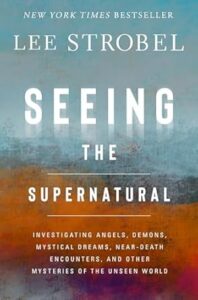Amid the playful affair of Halloween, a most earnest and momentous question about spiritual manifestations:
Is it just possible some phenomena in this often drifting, directionless, depraved physical plain are just too joyous and resplendent to be of the natural realm?
Answer: Absolutely.
And few things reflect that unseen spiritual splendor better than skeptical-journalist-turned-Christ-convert Lee Strobel’s newest book Seeing the Supernatural: Investigating Angels, Demons, Mystical Dreams, Near-Death Encounters, and Other Mysteries of the Unseen World.
In a tireless quest for truth, Strobel takes the reader along with him for absorbing interviews with scientific, scholarly and scriptural experts who recount the now innumerable heavily researched case studies across centuries of deathbed visions, near-death experiences and other spiritual encounters that provide compelling, indeed stunning, evidence of the afterlife.

Importantly, in keeping with the mold he cast in his landmark 1998 The Case for Christ: A Journalist’s Personal Investigation of the Evidence for Jesus, his newest book isn’t so much a theistic pursuit as a journalistic one.
It’s frankly staggering, the amount of dispassionate scientific study that has failed to debunk the spiritual phenomena in our midst – and, in fact, has only done the opposite: provided such a convincing plethora of evidence for the spiritual world that it would be a greater leap of faith not to believe in it.
For example:
- One study found 88% of patients at a hospice facility in New York reported deathbed visions – though even that could be understated, as the other 12% included people who might not have been able to communicate what they’d seen.
- One scientific relay team worked over 90 years analyzing 30,000 cases and produced a 10-volume report on spiritual appearances covering nearly 6,000 pages.
- A 19th-century study of 17,000 people found 10% had seen people who weren’t physically there – often somebody who just died.
At times, research has been so thorough it’s included teams stretching over nearly a century that have produced As Strobel notes, two researchers who focused on more than 3,000 cases concluded such experiences “are definitely not hallucinations, fantasies or memories caused by grief, nor are they projections of the subconscious mind or products of an overactive imagination.”
So, what are people seeing, hearing and feeling? Deceased loved ones, angels, peace-filling brilliant lights and beautiful music – and, quite often, Jesus.
In some cases, people have reported seeing loved ones from the other side who they didn’t even know had died. One young mother dying after childbirth not only saw her deceased father beckoning her, but her sister as well, who had died recently. The dying mother hadn’t even been told of her sister’s death.
Interestingly, some of the most credible reports of spiritual visions come from dying children. Only adding to their credibility is when they describe what they’ve seen to their parents:
When one child asked her mother if she could see the angels in her hospital room, the mother pretended to, talking about their wings. “Mama, you don’t have to lie,” the child said, explaining the angels had no wings – indicating the child’s vision was pure and unadulterated by art history’s arbitrary (and non-biblical) depictions of them.
Beyond the untold hundreds of thousands of heavily researched cases of spiritual visions in the material world, there have to be millions more stories as yet untold by people hesitant to appear mad.
Most importantly, though, consider the implications that flow from proof of the spiritual realm and an afterlife. How should it color the way we live in the here and now? Knowing or even suspecting what awaits us, should we not be happier? Kinder? More loving? More hopeful and purpose-filled? Less materialistic? Less self-absorbed?
Legendary Holocaust survivor Dr. Viktor Frankl cited what he called the “neurotic triad” that fills the “existential vacuum” of meaninglessness in so many desperate souls’ lives: aggression, depression and addiction.
Perhaps to that ancient toxic threesome we could add two modern scourges of emptiness and triviality: materialism and narcissism.
Lee Strobel’s refreshing research into the indescribable hope provided by glimpses of the unseen may be just what the doctor ordered.

